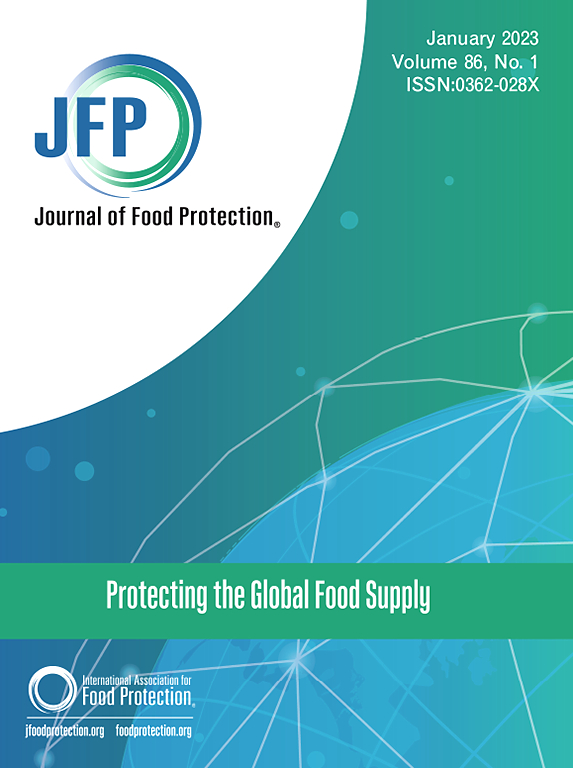Assessing Hot Water Reconstitution Instructions and Labeling of Powdered Infant Formula to Ensure Cronobacter spp. Reduction
IF 2.8
4区 农林科学
Q3 BIOTECHNOLOGY & APPLIED MICROBIOLOGY
引用次数: 0
Abstract
Cronobacter spp. contamination in powdered infant formula (PIF) can cause infections in high-risk infants. Public health guidelines for caregivers of high-risk infants advise reconstitution of PIF using water heated to at least 70 °C (158 °F) for microbial inactivation. This study evaluated changes to water temperature under different heating and cooling scenarios during formula preparation, aiming to identify which conditions best ensure a minimum treatment temperature of 158 °F (70 °C). Vessel type, lid usage, vessel removal from the heat source, and water volume were tested for their effects on heat retention. The “hot shot” method which uses a small volume of hot water followed by a larger volume of cooled water was also evaluated. In many scenarios, water temperatures fell below 158 °F (70 °C) during the steps prior to PIF reconstitution. The water temperature prior to transfer to the bottle, bottle material, and capacity, and volume of transferred water significantly impacted temperature (p < 0.001). The temperature of formula immediately following shaking was as high as 179.5 ± 1.6 °F (81.9 ± 0.9 °C) and as low as 138.0 ± 1.3 °F (58.9 ± 0.7 °C), depending on the preparation conditions. Bottle material and capacity, water volume, and initial water temperature significantly impacted the temperature of reconstituted PIF. Small volumes (2 fl. oz) of water in small glass bottles cooled the quickest. The hotshot method yielded temperatures well below 158 °F (70 °C). Measuring the temperature of hot water in the bottle and adding PIF when it cooled to 165 °F (73.8 °C) resulted in formula temperatures at or above 158 °F (70 °C) in almost all cases achieving a >5 log CFU/mL C. sakazakii reduction. However, 30 s of passive cooling was required to ensure pathogen lethality. PIF labels were reviewed, and lacked detailed information about how caregivers of high-risk infants should use hot water to reconstitute PIF. Our findings can help shape guidelines that improve PIF reconstitution practices.
评估婴儿配方奶粉的热水重组说明和标签以确保克罗诺杆菌的减少。
婴儿配方奶粉(PIF)中的克罗诺杆菌污染可导致高危婴儿感染。高危婴儿护理人员的公共卫生指南建议使用加热到至少70°C(158°F)的水重建PIF以灭活微生物。本研究评估了配方制备过程中不同加热和冷却条件下水温的变化,旨在确定哪种条件最能确保最低处理温度为158°F(70°C)。测试了容器类型、盖子的使用、容器从热源移除和水量对保温的影响。并评价了用小体积热水接大体积冷水的“热射法”。在许多情况下,在PIF重构之前的步骤中,水温低于158°F(70°C)。转移到瓶前的水温,瓶的材料,容量和转移水的体积显著影响温度(p5 log CFU/mL)。然而,30 s的被动冷却需要确保病原体的致病性。对PIF标签进行了审查,缺乏关于高危婴儿护理人员应如何使用热水重建PIF的详细信息。我们的发现可以帮助制定改进PIF重建实践的指导方针。
本文章由计算机程序翻译,如有差异,请以英文原文为准。
求助全文
约1分钟内获得全文
求助全文
来源期刊

Journal of food protection
工程技术-生物工程与应用微生物
CiteScore
4.20
自引率
5.00%
发文量
296
审稿时长
2.5 months
期刊介绍:
The Journal of Food Protection® (JFP) is an international, monthly scientific journal in the English language published by the International Association for Food Protection (IAFP). JFP publishes research and review articles on all aspects of food protection and safety. Major emphases of JFP are placed on studies dealing with:
Tracking, detecting (including traditional, molecular, and real-time), inactivating, and controlling food-related hazards, including microorganisms (including antibiotic resistance), microbial (mycotoxins, seafood toxins) and non-microbial toxins (heavy metals, pesticides, veterinary drug residues, migrants from food packaging, and processing contaminants), allergens and pests (insects, rodents) in human food, pet food and animal feed throughout the food chain;
Microbiological food quality and traditional/novel methods to assay microbiological food quality;
Prevention of food-related hazards and food spoilage through food preservatives and thermal/non-thermal processes, including process validation;
Food fermentations and food-related probiotics;
Safe food handling practices during pre-harvest, harvest, post-harvest, distribution and consumption, including food safety education for retailers, foodservice, and consumers;
Risk assessments for food-related hazards;
Economic impact of food-related hazards, foodborne illness, food loss, food spoilage, and adulterated foods;
Food fraud, food authentication, food defense, and foodborne disease outbreak investigations.
 求助内容:
求助内容: 应助结果提醒方式:
应助结果提醒方式:


